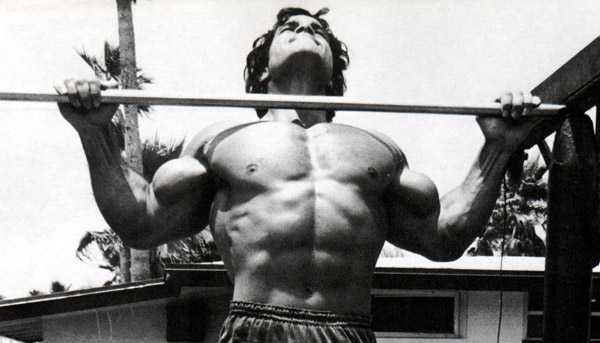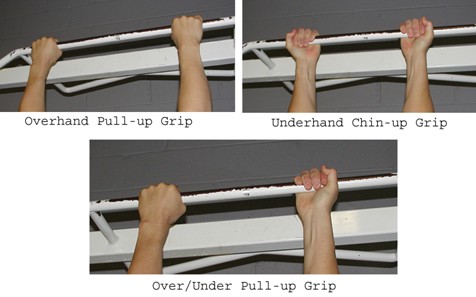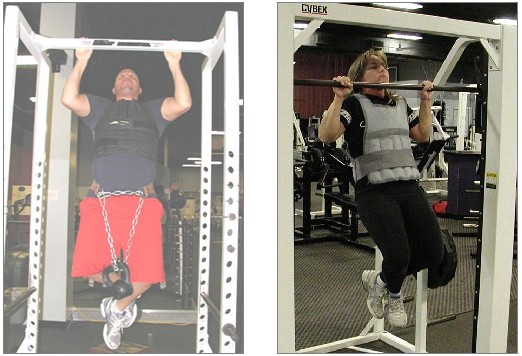If the squat is the king of all exercises, then the pull-up should be acknowledged with the same royalty. Simply stated, the pull-up is the squat for the upper body.
The squat is the unrivaled king of all strength training exercises. It is unparalleled in its overall effectiveness at taxing the entire body. The ankle, hip, and knee joints are all in motion thus ensuring that nearly every major leg muscle is utilized. Additionally, one’s hips, entire back, shoulders, and abdominals are also stressed. The squat is the cornerstone movement of any strength and conditioning program. If you were only allowed to perform one exercise, the squat would be the best choice as it strengthens nearly everything. An argument can also be made for the deadlift or the clean and jerk. However, the squat works more muscles than the deadlift and the clean and jerk is so highly technical that skill proficiency is not easily attained. Conversely, most people can learn to squat.
If the squat is the king of all exercises, then the pull-up should be acknowledged with the same royalty. Simply stated, the pull-up is the squat for the upper body. The pull-up is an upper body compound pulling exercise where the body is suspended by straightened, fully extended arms, then pulled up until the elbows are bent and the head is higher than the hands or bar from which you are pulling. The pull-up is characterized by hand position. An overhand (pronated) grip is used during the pull-up whereas an underhand (supinated) grip denotes the similar chin-up. The exercise primarily targets the Latissimus Dorsi muscle group in the back along with many other assisting muscles. These assisting muscles include the Brachialis, Brachioradialis, Biceps Brachii, Teres Minor, Teres Major, Deltoids, Infraspinatus, Rhomboids, Levator Scapulae, Trapezius, and Pectoralis Minor. Even the Triceps Brachii act as a dynamic stabilizer during the pull-up. The more muscles a movement utilizes, the more benefit the body receives. Accordingly, compound exercises give you a bigger bang for your buck.
There are numerous types of pull-ups. Most differentiations occur with regard to hand placement. (See Photo 1 below)
The standard pull-up is performed with both hands placed in an overhand grip. As previously stated, the chin-up is performed with an underhand palms facing up grip. Additional variations include the over/under grip like that which is used while deadlifting. One hand is placed over the bar and the opposite hand is placed under the bar. Some power racks have bars that allow your palms to face each other. This is known as a parallel or neutral grip. I recommend this grip for anyone that may have lingering shoulder issues. The super strong may even perform a one arm pull-up. This provides you with six different grip variations. Grip width is another way of varying the movement. Normally, your hands should be placed just slightly wider than shoulder width. Performing pull-ups with an ultra-wide grip is asking for trouble. It places additional stress on the shoulder and is not recommended. Anyone that knows anything about shoulder anatomy knows that all pressing or pulling motions should be performed in front of the body rather than behind the head. Behind the head motions can cause shoulder impingement syndrome and lead to other more debilitating injuries. Pull-ups performed with too narrow a grip will inhibit movement performance and make it more difficult to perform a full range repetition.
Pull-ups are characterized as a bodyweight exercise meaning that one uses only their own bodyweight as resistance for the movement. This ensures that the weight being lifted is always the same. Bodyweight exercises are the ideal choice for those interested in fitness and strength but do not have access to strength training equipment. Special equipment is rarely needed other than a bar to pull from. However, like the squat, deadlift, and overhead press, the pull-up is too valuable an exercise to avoid even in the absence of equipment. In July 2007, during a two week missions trip in Africa, I knew I could not afford to skip pull-ups. Consequently, I performed them while hanging from tree branches. Twelve-time national champion Sioux-z Hartwig-Gary feels similarly and celebrated the new year by performing pull-ups from a pipe on the upper deck of a cruise ship.
People who weigh less should, in theory, be able to do more pull-ups than people who weigh more or are overweight. My best friend tips the scales at nearly 240 pounds and does nothing but complain and give excuses as to why he can’t do many pull-ups. I’ve heard it all, “I’m too heavy. I’m too big. My legs are bigger than yours.” No sir, you just suck at pull-ups. Most of the time people will avoid what doesn’t come naturally or things they’re not proficient at. Stop making excuses and just do them. Like other strength training exercises, performing pull-ups is a skill. Skill mastery is best acquired through frequent practice. Do not allow your initial lack of skill and strength to dissuade you from doing them. If you’re new to pull-ups, perform them more frequently with just your bodyweight. Three times per week is not out of the question.
Many novices are not yet strong enough to lift their entire bodyweight through the full range of motion that a pull-up requires. This leaves them with three options. The first option maintains the integrity of a free weight movement. Jump Stretch bands may be used by hanging a band over a bar and looping the band around your body. The stretched rubber band will then act by giving you a vertical “push” effect helping to propel you upward. (See Photo 2 below)
The second option requires the use of a special machine. I detest machines for a multitude of reasons but mainly for the fact that they provide little neurological benefit. However, the Cybex Assisted Dip/Chin is one of the very few machines that I would actually endorse. This machine enables you to stand on a step that supports part of your bodyweight and assists you by pushing you upwards. (See Photos 3 and 4 below)
When you become stronger you need less assistance from the machine. Some of you may recall the original version of this machine known as the Gravitron made by Stairmaster.
A third option is inverted rows. Others have their partner assist them by holding their legs or spotting them at the waist. I do not recommend this method as the spotter usually ends up doing more work than the trainee. I also recommend avoiding lat pulldown machines. Contrary to popular belief, lat pulldowns will not improve your ability to do pull-ups. I abhor the lat pulldown machine. How many times have you seen some clown hop down on a lat pulldown machine and with all the momentum they can muster, swing and cheat their way to ten reps with 250 pounds? These are the same fools that can’t even do one proper pull-up. Pull-ups will make you brute strong. Period. Stick to bodyweight exercises and free weight movements with barbells, dumbbells, kettlebells, or other strength implements. This will always have a greater strength transfer to real world activities, sports, and PRs on the platform.
Another type of pull-up is an explosive version known as the Kipping Pull-up. To perform the Kipping Pull-up, you develop momentum in the horizontal plane and then transfer it to the vertical plane. In other words if you simply try to do pull-ups faster, eventually the swinging movement will occur. Speaking strictly from a fitness perspective, such as the CrossFit methodology, capacities for both work and power increase due to more work being done in less time. This translates to greater intensity. Greater intensity means better fitness. There is also an integration of upper and lower extremities working as a whole that is a gateway athletically to many other hip/upper body coordinations. This movement correlates immensely to other powerful movements like the power clean and the snatch.
Although pull-ups help the deadlift and bench press more, they act as an assistance movement for all three powerlifts. Implementing pull-ups into your weekly training plan will provide innumerable benefits. The strength built from pull-ups directly translates to increased pulling strength for the deadlift. Increased development in the Trapezius will help create a larger shelf for the bar to sit on while squatting. Moreover, the increased upper back strength helps during the eccentric phase of the bench press by affording greater control of the barbell. Pull-ups will also help prevent shoulder injuries via a more balanced muscular development.
Pull-ups may be performed as an assistance exercise on deadlift or bench press days. I prefer to do pull-ups on deadlift day and then perform some other type of free weight rowing movement on bench press days. Powerlifters don’t need to do high reps in the pull-up. This makes it easier to master the movement and add it into your arsenal. First you’ll want to test yourself to see if you’re currently strong enough to do a properly executed pull-up. Find a pull-up bar or the top of a power rack, jump up, and go for it. Start from a dead hang with arms fully extended and then pull yourself up until your chin is all the way above your hands and the bar from which you are pulling. Then lower yourself under control and return to the fully extended position. This constitutes one repetition. Perform as many reps as you can and this should give you a good idea of your current state of pull-up preparedness. If you’re not strong enough to perform a single rep, then use the rubber band method or the aforementioned assisted dip/chin machine. Another method of acclimating to pull-ups is the negative-only repetition method. Stand on a chair or box, jump up and remain in the top position of the pull-up for as long as possible. Squeeze the bar as tightly as possible, tighten your biceps and back muscles and try not to let go of the bar. Fight it for as long as you can and slowly lower yourself to the fully extended position. This allows you to perform the eccentric phase of the movement. We can all lower more weight than we can lift so this method proves useful when trying to build up to a perfect rep. A few sets of negative only pull-ups will leave you exhausted. Perform them after your assisted reps.
For trainees that are already strong enough to perform pull-ups, you’re ahead of the curve. I recommend performing a minimum of three sets and keeping the reps near five. Personally, I prefer five sets of five reps. Once I can achieve five by five with my bodyweight, I start adding weight. (See Photos 5 and 6 below)
I prefer using a weight vest as it’s safer and feels more like true bodyweight. Dip and chin belts can be useful but require more set-up and can leave your groin exposed. Keep adding weight until five sets of five is no longer attainable. Then switch to six sets of four reps. I’ve even done eight sets of three reps. This maintains a consistent training volume while allowing you to train even heavier. Avoid using lifting straps to perform pull-ups especially if your grip is weak. Pull-ups place a tremendous demand upon the hands and will enhance your grip and finger strength. I rarely train to failure with pull-ups unless I’m testing for max reps. My PR for max reps is 17 reps at a bodyweight of 195 pounds. As I had never attempted a one rep max (1RM) in the pull-up, I decided to do a little experiment and see what I could do. On September 26, 2007, at a bodyweight of 223 pounds, I performed one full range repetition (from a dead hang using an overhand grip) with 95 pounds added via weight vests and a dip/chin belt. That equates to a 318-pound pull-up. Since then, as a further experiment, I’ve used Prilepin’s table to manipulate my pull-up training volume. Though Prilepin’s findings were based upon Olympic lifters performing barbell moves, I’ve had positive results employing the table to my pull-up training. The multiple sets at lower reps (usually three to six) has strengthened my back immensely. What makes Prilepin’s table so valuable is the reinforcement of the virtue that it is always better for powerlifters to build their training volume via the number of sets performed rather than the number of reps. This is especially true in the competitive lifts as it affords more practice and skill mastery.
Do not be the athlete or lifter that neglects training their back. Just because you can’t look into a mirror and immediately see your back doesn’t mean to avoid training it. Many folks want to spend all their time looking in the mirror and working on aesthetics. Far too many people neglect training the back side of their bodies. This is a huge mistake. For athletes and powerlifters, your body is like a high performance vehicle. The front side of your body is just the hood ornament and the paint job. It may look nice but it doesn’t really do much. Your posterior musculature is your engine. It’s the horsepower that drives the car. Pull-ups are one way to generate that horsepower.
Form without function is useless. Make sure you’ve got something under your hood or you just might get run over.





